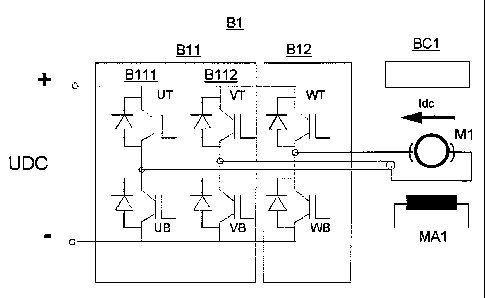Some of the information on this Web page has been provided by external sources. The Government of Canada is not responsible for the accuracy, reliability or currency of the information supplied by external sources. Users wishing to rely upon this information should consult directly with the source of the information. Content provided by external sources is not subject to official languages, privacy and accessibility requirements.
Any discrepancies in the text and image of the Claims and Abstract are due to differing posting times. Text of the Claims and Abstract are posted:
| (12) Patent: | (11) CA 2463832 |
|---|---|
| (54) English Title: | FULL WAVE DC/DC CONVERTER |
| (54) French Title: | CONVERTISSEUR CONTINU-CONTINU A DOUBLE ALTERNANCE |
| Status: | Expired and beyond the Period of Reversal |
| (51) International Patent Classification (IPC): |
|
|---|---|
| (72) Inventors : |
|
| (73) Owners : |
|
| (71) Applicants : |
|
| (74) Agent: | ROBIC AGENCE PI S.E.C./ROBIC IP AGENCY LP |
| (74) Associate agent: | |
| (45) Issued: | 2006-11-07 |
| (86) PCT Filing Date: | 2002-09-24 |
| (87) Open to Public Inspection: | 2003-05-30 |
| Examination requested: | 2004-07-27 |
| Availability of licence: | N/A |
| Dedicated to the Public: | N/A |
| (25) Language of filing: | English |
| Patent Cooperation Treaty (PCT): | Yes |
|---|---|
| (86) PCT Filing Number: | PCT/FI2002/000767 |
| (87) International Publication Number: | WO 2003044935 |
| (85) National Entry: | 2004-04-16 |
| (30) Application Priority Data: | ||||||
|---|---|---|---|---|---|---|
|
A control unit of controlling a direct-current load (M1), said control unit
comprising a DC/DC bridge (B1) provided with controllable semiconductor
switches (UT, UB, VT, VB, WT, WB) and having two bridge sections (B11, B12),
one (B12) of which conducts direct current while the other one (B11) is
controlled via PWM to regulate the current magnitude. The bridge section
controlled via PWM consists of two bridge arms (B111, B112), and the
semiconductor switches (UT, UB, VT, VB) in these bridge arms are turned on
alternately.
Unité de contrôle servant à contrôler une charge de courant continu (M1) et comprenant un pont continu-continu (B1) pourvu de commutateurs à semi-conducteur contrôlables (UT, UB, VT, VB, WT, WB) et possédant deux parties pont (B11, B12), dont l'une (B12) véhicule le courant continu, tandis que l'autre (B11) est contrôlée par l'intermédiaire de PWM afin de réguler l'intensité du courant. La partie pont contrôlée par l'intermédiaire de PWM est constituée par deux bras (B111, B112) et les commutateurs à semi-conducteur (UT, UB, VT, VB) de ces bras sont mis en service alternativement.
Note: Claims are shown in the official language in which they were submitted.
Note: Descriptions are shown in the official language in which they were submitted.

2024-08-01:As part of the Next Generation Patents (NGP) transition, the Canadian Patents Database (CPD) now contains a more detailed Event History, which replicates the Event Log of our new back-office solution.
Please note that "Inactive:" events refers to events no longer in use in our new back-office solution.
For a clearer understanding of the status of the application/patent presented on this page, the site Disclaimer , as well as the definitions for Patent , Event History , Maintenance Fee and Payment History should be consulted.
| Description | Date |
|---|---|
| Common Representative Appointed | 2019-10-30 |
| Common Representative Appointed | 2019-10-30 |
| Time Limit for Reversal Expired | 2019-09-24 |
| Change of Address or Method of Correspondence Request Received | 2018-12-04 |
| Letter Sent | 2018-09-24 |
| Inactive: IPC expired | 2016-01-01 |
| Inactive: Correspondence - MF | 2010-08-10 |
| Grant by Issuance | 2006-11-07 |
| Inactive: Cover page published | 2006-11-06 |
| Pre-grant | 2006-08-25 |
| Inactive: Final fee received | 2006-08-25 |
| Notice of Allowance is Issued | 2006-07-13 |
| Letter Sent | 2006-07-13 |
| Notice of Allowance is Issued | 2006-07-13 |
| Inactive: IPC assigned | 2006-07-06 |
| Inactive: IPC assigned | 2006-07-06 |
| Inactive: IPC assigned | 2006-07-06 |
| Inactive: IPC assigned | 2006-07-06 |
| Inactive: IPC assigned | 2006-07-06 |
| Inactive: Approved for allowance (AFA) | 2006-06-28 |
| Inactive: IPC from MCD | 2006-03-12 |
| Amendment Received - Voluntary Amendment | 2004-12-08 |
| Letter Sent | 2004-09-16 |
| Letter Sent | 2004-08-18 |
| All Requirements for Examination Determined Compliant | 2004-07-27 |
| Request for Examination Requirements Determined Compliant | 2004-07-27 |
| Inactive: Single transfer | 2004-07-27 |
| Request for Examination Received | 2004-07-27 |
| Inactive: Courtesy letter - Evidence | 2004-06-15 |
| Inactive: Cover page published | 2004-06-15 |
| Inactive: Notice - National entry - No RFE | 2004-06-11 |
| Application Received - PCT | 2004-05-14 |
| National Entry Requirements Determined Compliant | 2004-04-16 |
| Application Published (Open to Public Inspection) | 2003-05-30 |
There is no abandonment history.
The last payment was received on 2006-06-13
Note : If the full payment has not been received on or before the date indicated, a further fee may be required which may be one of the following
Please refer to the CIPO Patent Fees web page to see all current fee amounts.
Note: Records showing the ownership history in alphabetical order.
| Current Owners on Record |
|---|
| KONE CORPORATION |
| Past Owners on Record |
|---|
| ESA PUTKINEN |
| PEKKA JAHKONEN |